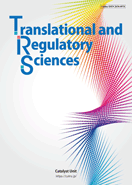Volume 4, Issue 3
Displaying 1-3 of 3 articles from this issue
- |<
- <
- 1
- >
- >|
Full Paper
-
2022 Volume 4 Issue 3 Pages 53-60
Published: 2022
Released on J-STAGE: December 20, 2022
Advance online publication: November 04, 2022Download PDF (839K) Full view HTML
Short Communication
-
2022 Volume 4 Issue 3 Pages 61-67
Published: 2022
Released on J-STAGE: December 20, 2022
Advance online publication: November 01, 2022Download PDF (979K) Full view HTML
Review
-
2022 Volume 4 Issue 3 Pages 68-75
Published: 2022
Released on J-STAGE: December 20, 2022
Advance online publication: October 04, 2022Download PDF (2800K) Full view HTML
- |<
- <
- 1
- >
- >|
